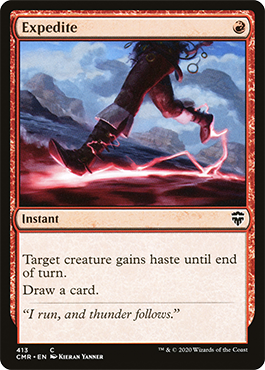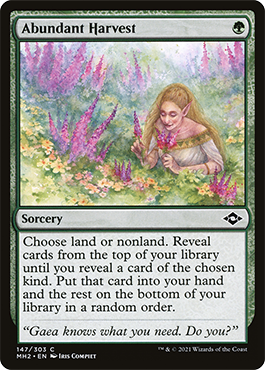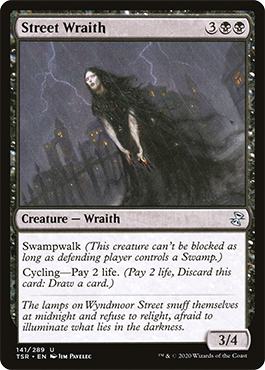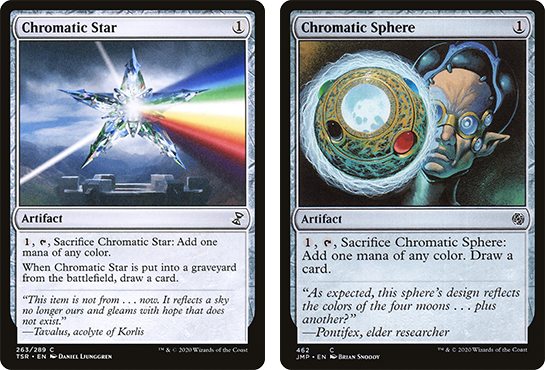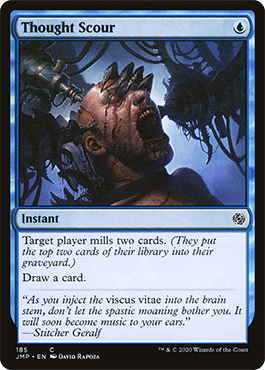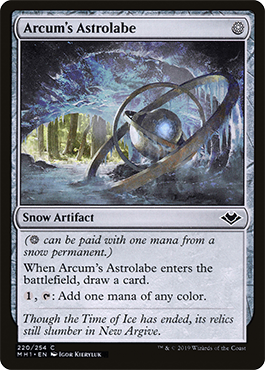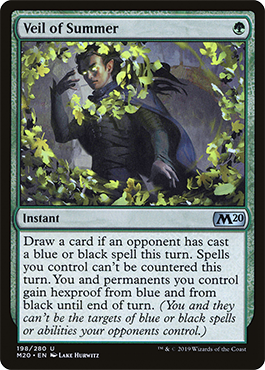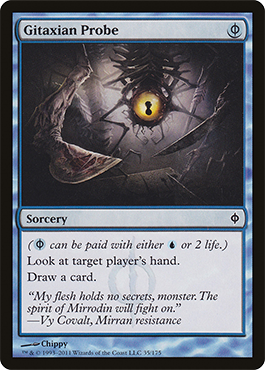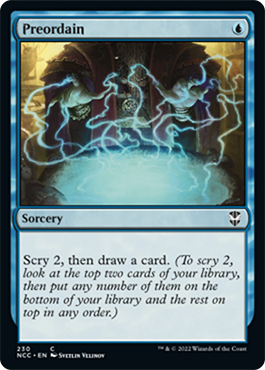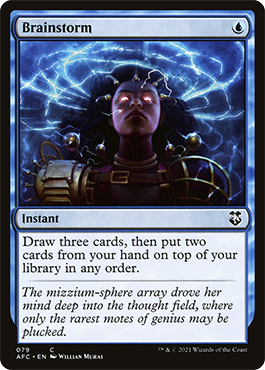Cantrips are some of the most useful cards in Magic, and come in all different forms. Scott ranks the Top 20 Cantrips of all time!
Cantrips are a staple of almost every format. They can help smooth out a deck’s operation, sculpt the perfect hand for a combo turn, or be used as a cheap way to enable spell-based payoffs. They are some of the most flexible and satisfying spells to cast, and offer a wide range of extra benefits that can add polish to an already impressive deck. Sometimes, they can even become the star of the show! They’re my favorite kind of spells to cast, which is why I’m going to count down the top twenty cantrips in Magic. But first:
What Is A Cantrip?
There has always been a lot of debate over the exact definition of a cantrip in Magic, with opinions sometimes varying wildly from player to player. I asked the question recently on Twitter, and I got a lot of varied responses. Some people’s definitions were vague, like “cantrips are cards that replace themselves”, and some players were significantly more verbose and comprehensive. There were even some radical cantrip statements: some believe that Thoughtseize is a cantrip, as instead of replacing itself, it reduces your opponent’s resources by one card. One player even believed that Ribbons of Night is a cantrip!
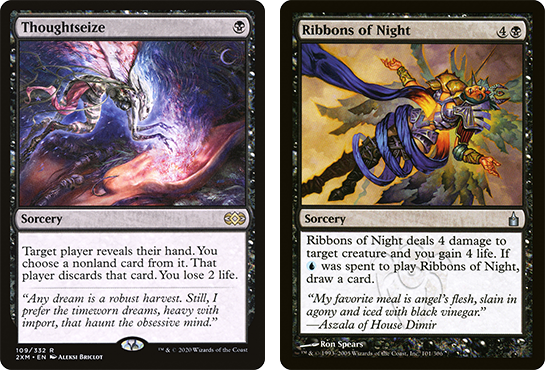
Cantrips.
I’m not here to debate anyone’s personal definition of a cantrip, and I don’t think there is a strictly right or wrong answer. In order to make a top 20 list, however, I do have to follow some form of guideline. My definition for this list is:
“A cantrip is a card that costs one mana or less to cast, and can immediately replace itself upon resolution, or when it enters the battlefield”
No single explanation is going to work for everyone, and there will be some exceptions to the rule, but it’s close enough for my list! But before we start, there are some honorable mentions…
Honorable Mentions
Experimental Synthesizer is the newest card here, and it’s packed full of value. The only reason it’s not on the list is because the card it provides you with must be played on that turn, meaning it’s not always a cantrip. You can’t play this on turn one and guarantee that you get any value from it at all, for example.
Manamorphose is arguably a zero mana cantrip, depending on how you look at it. It does require an initial investment of two mana though, meaning that it technically doesn’t fit the definition. It would likely be very high up on the list if it did, as it’s known for its affiliation with combo decks and how it technically reduces a deck from 60 to 56 cards.
Gamble is definitely a tutor. However, it technically fits the description of a cantrip: it costs one mana to cast, and it leaves you with the same number of cards in hand. This is one of the exceptions to the rule, and as a result isn’t included in the top 20.
Ancient Stirrings is so powerful that at one point some players considered it worthy of a ban in Modern. Like Experimental Synthesizer, it does fit the definition, but there is a chance that you get nothing from it. You also have to build your deck a certain way to guarantee any reliability with it, and for that reason it’s only an honorable mention.
20. Defiant Strike
It doesn’t seem like much, but this kind of effect is extremely potent in the right deck. Feather, the Redeemed loves this in Commander, and the heroic decks of Pioneer and Standard past used this as a way to apply pressure while keeping their hands well stocked.
19. Expedite
Expedite is emblematic of red cantrips, granting a small creature based benefit while replacing itself. It may need a creature on board to target, but that can often be a benefit, especially in Commander. Zada, Hedron Grinder turns this cantrip into a build-your-own Ancestral Recall, and you can ambush opponents by giving haste to Shu Yun, the Silent Tempest.
18. Quicken
There’s no feeling quite like an instant speed Supreme Verdict. This was a play synonymous with UW Control in Return to Ravnica/Theros Standard, which is widely looked back upon with great fondness by many players.
17. Abundant Harvest
Abundant Harvest is perfect for those that want to guarantee hitting their land drops, and to always find something to do later on. Just one mana for a one-time Abundance effect is a great rate, and it’s a cantrip that I think is really underrated.
16. Overmaster
Legacy Ruby Storm players will be very familiar with this one. Overmaster guarantees that your next instant or sorcery spell will resolve, which is essential in formats with Force of Will and Daze. This also sees play at higher levels in Commander, to help push spells past the blue player’s two untapped islands.
15. Street Wraith
Okay, Street Wraith technically doesn’t fit my exact definition of a cantrip as you don’t cast it, but it’s one I’m willing to make an exception for. This sees play in all formats that it’s legal in, from Cycling Storm in Pauper to Living End and Death’s Shadow in Modern to Doomsday in Vintage. It’s similar to Manamorphose because it technically reduces the size of your deck by being a “free” redraw, but it’s also used in Living End as an extra creature to reanimate, and by Death’s Shadow to surgically control its life total.
14. Sleight of Hand
Sleight of Hand saw a lot of play in Modern, but often not by choice. Many combo decks, like Gifts Storm and Ad Nauseam, needed a critical mass of cantrips to ensure consistency, and this was one of the only ones available for a long time. With that said, it’s still exceptionally strong and is better than most non-blue cantrips.
13. Abundant Growth
If you asked me to make a top 20 cantrips list three years ago, I might not have included Abundant Growth. However, Yorion, Sky Nomad has now turned this into an exceptional cantrip. Not only does it fix the mana in the greedy four color decks in Modern, but it can also be flickered with Yorion for even more value.
12. Opt
It’s known that I love a good Opt, so refraining from putting it in the top 10 is my attempt to not appear biased. This old cantrip resurfaced in Ixalan, and has proven to be a boon for every format right back to Modern. It also seems to be the perfect level of power for Standard, given that it’s being repeatedly reprinted into Standard sets.
11. Chromatic Star/Chromatic Sphere
These two little artifacts are almost identical, and have shown up in countless decks since their first printing. They’re synonymous with Mono Green Tron, but they were also found in KCI and Eggs in Modern, and most recently Eggs Tron in Pauper. Again, they don’t technically fit the criteria as you need to pay another mana to crack them (even though you get it back immediately), but they’re so popular that they’re hard to ignore.
10. Thought Scour
Thought Scour has been the friend of graveyard and delve decks for a long time. Izzet Phoenix in Modern utilized this best pre-Faithless Looting ban, Death’s Shadow used it to greatly reduce the cost of Gurmag Angler, and now Izzet Murktide is doing the same for its namesake creature. Legacy High Tide often uses it too, and it’s seen in countless spellslinger decks in Commander. If you want cards in the bin, this is always a great consideration.
9. Serum Visions
Serum Visions was considered to be the number one cantrip in the Modern format for a long time, and is still among the best. It was the backbone of many combo decks like Ad Nauseam and Pyromancer Ascension as it set up their draws for one big turn; it was also used in Izzet Phoenix and Murktide decks as a way to help plan a turn or two ahead. It’s still one of the most popular ways to fix the top of the deck, and will likely remain a great setup card for some time to come.
8. Consider
One of the newest cards on the list, and it’s impressed people enough to warrant a top 10 inclusion. It’s effectively halfway between Opt and Thought Scour: you have some card selection, but you can also put cards into your graveyard. It sees play in Standard, and Pioneer decks like Izzet Phoenix make excellent use of it. It also sees play in Modern as the most flexible way to fuel a Murktide Regent or Snapcaster Mage.
7. Arcum’s Astrolabe
This is one card that took everyone by surprise. It does not look impressive at first glance, but it caused a number of problems in several formats. In Pauper, it became a “free” addition to almost any deck, and along with Prophetic Prism gave rise to monstrosities like “5 Color Mono Black”. It also allowed Modern and Legacy decks with several colors to circumvent punishing effects like Blood Moon and Wasteland, meaning there was virtually no weakness to them. It’s one of the most banned cards on this list, as it’s banned in all three of those formats!
6. Veil of Summer
Okay, this isn’t always a cantrip, but it’s only usually included when there is a very high chance that it will be a cantrip, so I’ll make another exception. The “One-Mana Cryptic Command” is the best friend of combo players, enabling you to dodge hand disruption or force spells through counters. If you have specific spells you need to resolve, it’s almost always right to try and splash green for this incredible sideboard card.
5. Mishra’s Bauble
When Lurrus of the Dream-Den was still legal in Modern and Legacy, Mishra’s Bauble might have made the top 3. It was added to almost every Lurrus deck, as you could play it for free from the graveyard on every turn. Even without Lurrus, it still does great work. It gives you information about the top of your deck, so you can use a fetch land to change the draw. It also helps turn on Dragon’s Rage Channeler quickly, and technically reduces deck size like Street Wraith and Manamorphose.
4. Gitaxian Probe
The list of formats that Gitaxian Probe is banned in is truly a testament to its power. It’s only legal in Commander and it’s restricted in Vintage, so there’s no official format where you can play more than one in a deck ever. It’s easily one of the most broken cards ever printed; Modern Storm used it for free storm count, Infect used it to check if the coast is clear to go all-in on a kill, and even Pauper Burn used it to reduce deck size and enable Ghitu Lavarunner and Firebrand Archer immediately. It’s likely we’ll never see a cantrip like this ever again.
3. Ponder
Arguably the best cantrip for combo decks, this Legacy staple has been a mainstay for some time. It’s ideal when you need to find very specific cards, as it technically gives you four looks (the top three, and the card you draw if you shuffle) which is more than any other cantrip. It’s also used to set up Delver of Secrets flips, and as a cheap way to dig for the right card in any situation in Commander.
2. Preordain
It’s wild how much of a difference the wording of a card can make. Serum Visions has the same basic parts (“scry 2” and “draw a card”), but Preordain’s ability to select the card you’re going to draw makes all the difference. This sees a lot of play where it’s legal, but unlike Ponder, it’s used more in fair decks. Its ability to dig for answers is better when your card quality is higher, and so gives you greater flexibility in most scenarios.
1. Brainstorm
No matter what card I picked for number one, it’s going to feel wrong to someone. Brainstorm is sometimes not even considered to be a cantrip by players, but it does end up fulfilling the criteria once it has resolved. You may end up with the same number of cards in your hand, but you get to choose the best hand out of an additional three cards. This is extremely potent, especially when mixed with shuffle effects like fetch lands. Some people claim that you can “Brainstorm lock” yourself if you don’t have a fetch land, but if you didn’t have Brainstorm, you’d be drawing those cards anyway. Moreover, it can be used to protect key cards from targeted discard by hiding them on the top of your deck. The utility and flexibility offered by this spell for just one mana makes it the best in class in my eyes.
It’s important to note that this is just my list, and it’s not going to align with everyone’s tastes. Also, just because a spell is higher up on this list, doesn’t mean it’s better than a lower ranked card for a specific purpose. It’s all subjective; make sure that you take the needs of the deck into account when you’re brewing, and you’ll find the right cantrip with ease.
What do you think of this list? Do you agree with any of them? All of them? None of them? I’d love to hear what you think, so be sure to let me know on Twitter. Happy cantripping!

Scott is an Irish content creator and the Head of Budget Magic for the Izzet League. He focuses on affordable decks in Pioneer, Modern, and Pauper, particularly ones that stray from the mainstream. When he’s not writing about his favorite decks, he can be found talking incessantly about them on Twitter and on The Budget Magic Cast.





